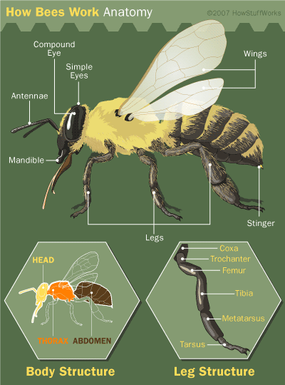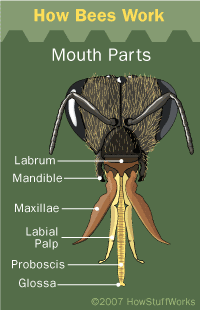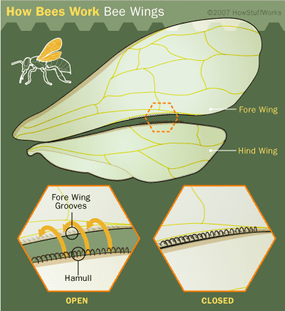Quck answer
Bees are fascinating creatures that play a critical role in pollinating plants and ensuring the survival of many species. They live in highly organized colonies, with each bee having a specific role to play in the hive. Worker bees gather nectar and pollen, while the queen bee lays eggs and the drones mate with the queen. Bees communicate through dances and pheromones, and their complex social structure allows them to work together efficiently. Unfortunately, bee populations are declining due to habitat loss and pesticide use, which could have devastating effects on our food supply. Efforts to protect and conserve bees are crucial for our ecosystem and economy.
Wildlife
The Anatomy of Bees

The assistance of pollinators such as bees is crucial for the reproduction of flowering plants.
Image courtesy MorgueFile
According to scientists, bees and flowering plants both came into existence approximately 100 million years ago during the Cretaceous period. Before this period, plants reproduced through cones and the wind dispersed the seeds and pollen. However, during the Cretaceous period, flowering plants or angiosperms emerged, which required assistance from insects and other animals for pollination. Insects, such as bees, were responsible for moving pollen grains from plants’ male structures (anthers) to their female structures (stigmas).
During this period, bees evolved from their wasp-like ancestors. Bees, unlike their carnivorous ancestors, became herbivores and fed on pollen and nectar from the newly-evolved plants, pollinating flowers as they went. The oldest known bee fossil is 100 million years old and has several wasp-like features, suggesting that bees and wasps both evolved from a mutual, wasp-like ancestor.
Bees still possess a few physical features shared with their wasp cousins. They also share some traits with ants, and together, bees, wasps, and ants make up the Hymenoptera insect order, which means “membranous wings.”
A bee’s body is similar to other insects and is largely covered in an exoskeleton made up of small, movable plates of chitin. Additionally, the body is covered in fuzzy branched hair, which assists in collecting pollen and regulating body temperature. The body consists of three sections: the head, thorax, and abdomen.


The bee’s brain is housed in its head, consisting of approximately 950,000 neurons, which are specialized and communicate with specific neighboring neurons. The brain’s division of tasks allows it to perform complex activities that would typically require a larger brain. The brain communicates with the rest of the body through a system of nerves.
Two sensory antennae and five eyes (three simple eyes called ocelli, and two compound eyes) are located on the bee’s head. The compound eyes are composed of repeating eye parts referred to as ommatidia, with around 150 ommatidia responsible for pattern detection, enabling bees to detect polarized light, which is an ability humans lack.
Like most insects, bees have complex mouthparts used for eating and drinking, with variations in size and shape among species. However, most bees have paired jaws or mandibles, a tongue or glossa, and two maxillae and a labrum, which support a proboscis or tube used for gathering nectar.
Bee Anatomy: Wings and Thorax

The thorax of a bee is where its two pairs of wings and three pairs of legs are attached. The wings, which are thin and delicate, are actually part of the bee’s skeleton. In most species, the front wings are larger than the back wings. The front and rear wings are connected by small hooks called hamuli, which allow them to beat together when the bee is in flight.
Next, we will take a closer look at the legs and infamous stinger of the bee.
FAQ
1. What is the role of bees in the ecosystem?
Bees play a crucial role in the ecosystem as pollinators. They transfer pollen from one plant to another, allowing for fertilization and the production of fruits, vegetables, and seeds. Without bees, many plants would not be able to reproduce, leading to a decline in food sources for both humans and animals.
2. How do bees communicate with each other?
Bees communicate with each other through a series of dances and pheromones. The most well-known dance is the waggle dance, in which a bee communicates the location of a food source to other bees. The direction and distance of the food source are conveyed through the angle and duration of the dance.
3. How do bees make honey?
Bees make honey by collecting nectar from flowers and storing it in their honey stomachs. The nectar is then regurgitated and passed from bee to bee until it reaches a honeycomb. The bees then fan their wings to evaporate the water in the nectar, creating a thick, sweet liquid we know as honey.
4. How many bees are in a colony?
A typical honey bee colony can contain anywhere from 20,000 to 60,000 bees. The colony is made up of a queen bee, who lays eggs, male drones, and female worker bees who carry out various tasks such as collecting food and caring for the young.
5. What is the lifespan of a bee?
The lifespan of a honey bee varies depending on its role in the colony. A queen bee can live up to five years, while male drones live for only a few weeks. Female worker bees can live for several months during the active season.
6. What is the importance of beekeeping?
Beekeeping is important for both the production of honey and the pollination of crops. It can also provide an income for beekeepers and promote the conservation of honey bee populations. Additionally, beekeeping can serve as a hobby and a way for individuals to connect with nature.
7. How do bees defend themselves?
Bees defend themselves and their colony by stinging. The stinger is a modified ovipositor, or egg-laying organ, that is only found in female bees. When a bee stings, it releases venom that can cause pain, swelling, and allergic reactions in some individuals.
8. What are the different types of bees?
There are many different types of bees, but the most well-known are honey bees, bumblebees, and solitary bees. Honey bees and bumblebees live in colonies, while solitary bees live alone. Other types of bees include carpenter bees, sweat bees, and leafcutter bees.
9. How are bees affected by pesticides?
Pesticides can have negative effects on bees, including decreased foraging ability, impaired navigation, and reduced reproductive success. Some pesticides are also toxic to bees and can lead to bee deaths and declines in bee populations.
10. How can individuals help protect bees?
Individuals can help protect bees by planting native flowers and avoiding the use of pesticides in their gardens. Supporting local beekeepers and purchasing honey from sustainable sources can also help promote bee conservation. Additionally, spreading awareness about the importance of bees and their role in the ecosystem can help inspire others to take action to protect these important pollinators.





Leave a Reply